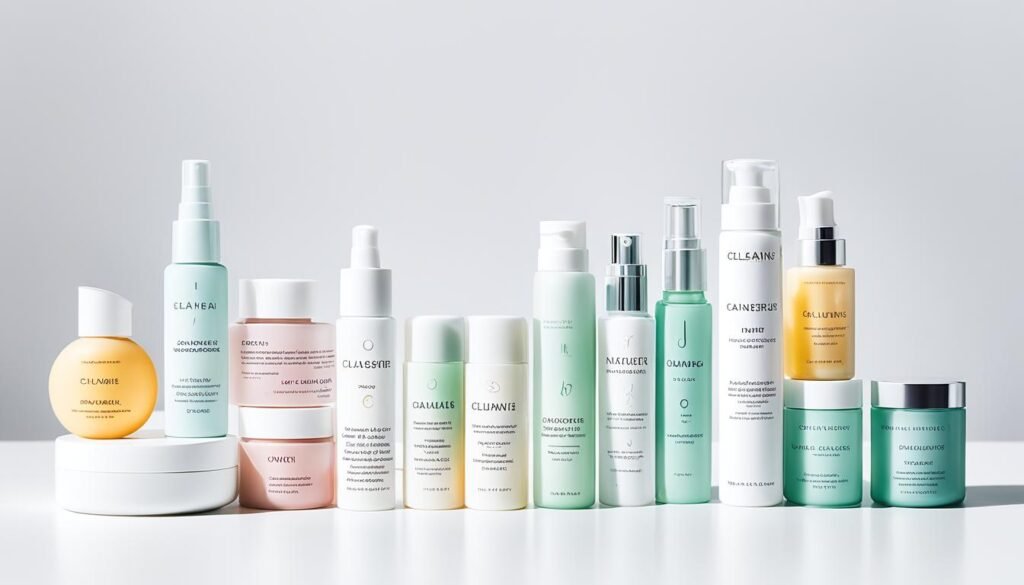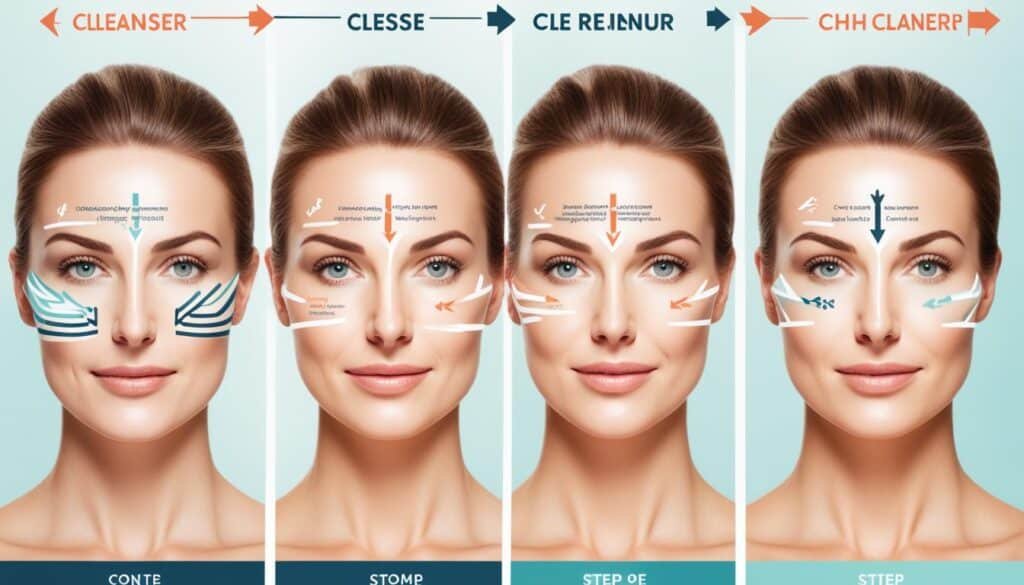How To Choose A Skincare Regimen Finding the right skincare routine is key to having healthy, glowing skin. It’s important to know your skin type and what issues you face. By creating a routine that fits your needs, you can take good care of your skin for the long term.
This guide will help you make an effective skincare plan. We’ll cover how to figure out your skin type, pick the best products, and stick to a routine.
Key Takeaways
- Understand your skin type to choose the right products
- Identify your specific skin concerns to address them
- Develop a customized skincare routine that meets your needs
- Cleanse and exfoliate regularly to maintain healthy skin
- Establish a consistent nighttime routine for optimal results
Understand Your Skin Type
The first step in choosing a skincare regimen is to determine your skin type. Knowing whether your skin is normal, dry, oily, or a combination will help you pick the right products and ingredients.
Normal Skin
Normal skin is balanced, with no too much oil or dryness. It looks smooth, even, and has a healthy glow. People with normal skin type usually don’t have many skin issues. They can use a wide range of skincare products.
Dry Skin
Dry skin often feels tight, flaky, and looks dull. It might also get red and irritated easily. Those with dry skin should look for moisturizing products. These products should help replace the skin’s natural oils and protect it from the environment.
Oily Skin
Oily skin looks shiny, greasy, and has big pores. It might also get more breakouts and blemishes. People with oily skin type should use products that are oil-free and help control oil production.
Knowing your unique skin type is key to building a good skincare routine. It helps you choose products and ingredients that meet your specific needs and concerns. By understanding your skin type, you can make better choices for your skincare.
Determine Your Skin Concerns
Finding out what skin concerns you have is key to a good skincare plan. Common skin issues and skin problems are aging, acne, hyperpigmentation, redness, and dryness. Knowing these skin conditions lets you pick the right products for your needs.
If you’re worried about aging, look for products with retinol, vitamin C, and hyaluronic acid. These ingredients help smooth out fine lines, increase collagen, and keep skin hydrated. For acne, choose products with salicylic acid or benzoyl peroxide. They help clear pores and lessen breakouts.
For hyperpigmentation like dark spots or uneven skin tone, try products with kojic acid, niacinamide, and alpha-arbutin. If your skin is often dry or dehydrated, use moisturizing and repairing ingredients like ceramides and glycerin.
By carefully checking your skin concerns, you can make a skincare routine that meets your needs. This way, you can get the healthiest, most glowing skin possible.
How To Choose A Skincare Regimen

Starting a good skincare routine means knowing what healthy skin needs. Cleansing and exfoliating are key steps. They get your skin ready for the skincare products you use.
Cleanse
Cleansing is crucial in your daily skincare routine. It takes away dirt, oil, and other stuff that builds up on your skin. Pick a cleanser that’s gentle and right for your skin type. Stay away from harsh cleansers that can dry out your skin.
Exfoliate
Exfoliating regularly keeps your skin looking bright and healthy. Exfoliators remove dead skin cells, open up pores, and help new cells come to the surface. Use a exfoliator 1-2 times a week, based on what your skin needs. Be careful not to exfoliate too much, as it can irritate your skin.
Adding these important skincare steps to your daily routine sets the stage for a personalized skincare regimen. This way, you can tackle your specific skin issues and reach your skincare goals.
Apply Products in the Right Order

Creating a good skincare routine is not just about picking the right products. It’s also about applying them in the right order. This ensures your skin absorbs the products well and gets the most out of your skincare steps.
Start with the lightest products and move to the heaviest. This lets each product work its best without being blocked by others. It’s like building a house, starting with the foundation and adding layers on top.
- Begin with a cleansing step to remove dirt and get your skin ready.
- Use a toner or essence to balance your skin’s pH and prepare it for more products.
- Apply targeted treatments or serums to address specific skin concerns.
- Lock in moisture with a hydrating moisturizer or facial oil.
- Finish with a sunscreen during the day to protect your skin from the sun.
Getting the hang of product layering might take some trial and error. But, it’s worth it. By layering your products in this way, you make sure each one works its best.
| Step | Product Type | Purpose |
|---|---|---|
| 1 | Cleanse | Remove impurities and prepare skin |
| 2 | Toner/Essence | Balance skin’s pH and enhance absorption |
| 3 | Serum/Treatment | Target specific skin concerns |
| 4 | Moisturizer | Lock in hydration |
| 5 | Sunscreen | Protect skin from UV damage |
“Proper product layering is the key to unlocking the full potential of your skincare routine.”
Establish a Nighttime Routine
Creating a nighttime skincare routine is key for your skin’s health and glow. At night, your skin repairs itself. This makes it the best time to use overnight skincare products. These products help nourish, hydrate, and fix any skin issues.
Here are steps to make the most of your nighttime skincare routine:
- Cleanse your skin: Begin by removing makeup, dirt, and impurities with a gentle, skin-friendly cleanser. This gets your skin ready for the next steps in your evening routine.
- Exfoliate: Use a mild exfoliating scrub or chemical exfoliant to remove dead skin cells. This helps your skin repair and rejuvenate itself overnight.
- Apply serums and treatments: Use strong serum formulas to tackle issues like fine lines, dullness, or uneven texture. Let these products soak in before you move on.
- Moisturize: Keep your skin hydrated and nourished with a rich, nighttime moisturizer that works while you sleep.
- Finish with eye cream: Don’t forget the delicate eye area. Apply a nourishing eye cream to reduce fine lines and dark circles.
By sticking to a nighttime skincare routine, you can use your skin’s natural repair and rejuvenation. You’ll wake up with a brighter, healthier complexion.
“Consistent nighttime skincare is the key to long-term skin health and vitality.”
Also Read: Skincare Routine For Glowing Skin: Top Tips For Radiance
Conclusion
Making a skincare routine that fits you is key to having healthy, glowing skin. Knowing your skin type and what it needs helps you pick the best products. Whether your skin is normal, dry, or oily, a good skincare regimen can change how your skin looks and feels.
It’s important to have a customized skincare plan for the best skin health. This guide shows you how to make a skincare routine that’s just right for you. By trying out different skin care tips, you can find what works best for your skin. Enjoy the benefits of having healthy, glowing skin.
With the right skincare regimen, you can start each day with confidence and a bright, refreshed look. Let personalized skincare help you reveal the beauty of your skin.
FAQs
Q: What is the best order to build a skincare routine?
A: The best order to build a skincare routine typically starts with washing your face with a gentle cleanser, followed by toners, serums, treatment products such as retinol or vitamin C, moisturizer, and finally sunscreen if it’s during the day.
Q: How can I determine the best skincare products that suit my skin type?
A: To determine the best skincare products that suit your skin type, start by identifying your skin type and concerns. For example, dry skin may require heavier moisturizers, while oily skin might benefit from lightweight, non-comedogenic products.
Q: What role does sunscreen play in a skincare routine?
A: Sunscreen plays a crucial role in a skincare routine as it helps to protect the skin from UV damage, preventing premature aging, discoloration, and other skin issues. It’s essential to use a broad-spectrum SPF daily, even on cloudy days.
Q: How do active ingredients like retinol and vitamin C benefit my skin?
A: Active ingredients like retinol and vitamin C are known for their ability to promote skin renewal and brighten the complexion. Retinol helps to reduce fine lines and wrinkles, while vitamin C acts as an antioxidant that helps to even skin tone and support the skin barrier.
Q: Can I use multiple serums in my skincare routine?
A: Yes, you can use multiple serums in your skincare routine, but it’s important to apply them in the correct order and to wait a few minutes between applications to allow each product to absorb properly. Start with the thinnest consistency and finish with the thickest.
Q: How do I choose products for mature skin?
A: When choosing products for mature skin, look for formulations that focus on anti-aging benefits, such as those containing retinoids, hyaluronic acid, and peptides. These ingredients help to improve skin texture, minimize fine lines and wrinkles, and promote a healthy glow.
Q: What should I do if I experience irritation from a new skincare product?
A: If you experience irritation from a new skincare product, it’s best to stop using it immediately. You should also consider consulting a dermatologist to determine whether the product is suitable for your skin type and to discuss alternative options.
Q: How often should I exfoliate my skin?
A: The frequency of exfoliation depends on your skin type and concerns. Generally, sensitive skin types may benefit from exfoliating once a week, while normal to oily skin types can exfoliate 2-3 times a week. Always choose a gentle exfoliant to avoid irritation.
Q: What is the purpose of a spot treatment in a skincare regimen?
A: A spot treatment is designed to target specific areas of the skin that require extra care, such as blemishes or dark spots. These treatments usually contain potent active ingredients that help to clear and brighten the affected area.




